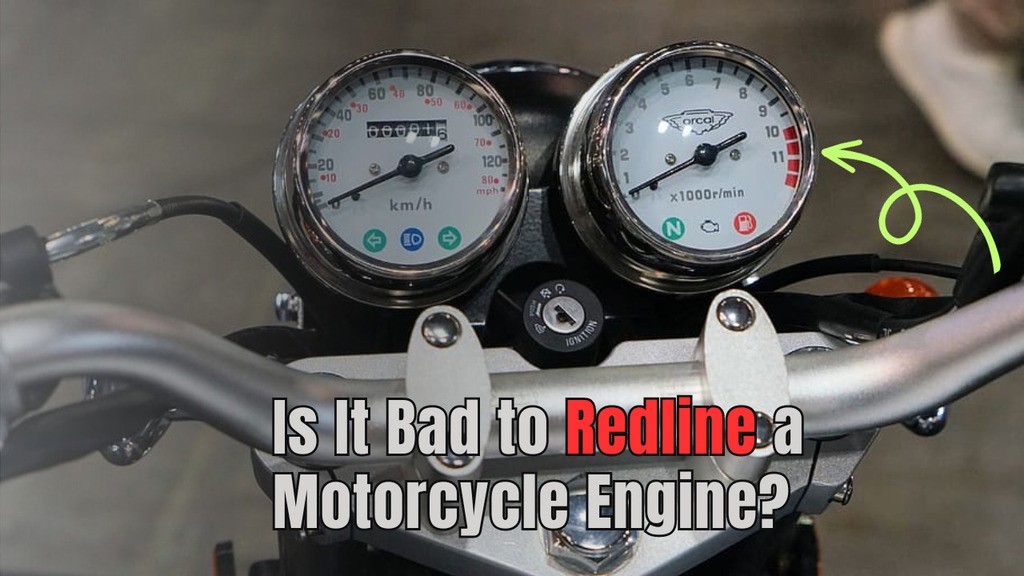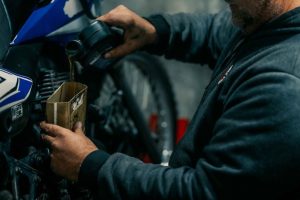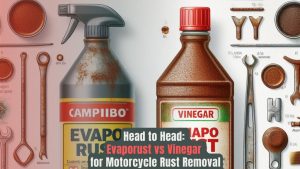Ever wondered how far you can push your motorcycle’s engine? We’ve all been tempted to wind it out to the rev limiter from time to time, really feeling the power surge. But is it bad to redline a motorcycle engine?
We’ll take a deep dive into when redlining is okay and when you should back off a gear. From design limits to track days, we’ll explore all the ins and outs of taking your bike to the max RPM.
What Is Redlining a Motorcycle Engine?
So we’ve all seen that little red section on the end of the tachometer, but what does it really mean to take your bike to the redline? Redlining simply refers to pushing your engine speeds all the way up to the maximum RPM marked by the red zone.
Every engine has a point where additional revs will start to cause damage, and that redline mark provides an indicated limit for how high you can safely rev in any given gear.
Now we’ve all gotten a little greedy with the throttle from time to time. But constantly hovering at those super high RPMs is no way to treat your bike.
Think of your engine like a top athlete – they can sprint at full capacity for short bursts, but try to maintain that pace continuously and they’ll crash hard. The same goes for your motor. Using the whole rev range and understanding how to appropriately wind it out up to and through the powerband will serve you much better in the long run.
Take Jim, my riding buddy. He always insists on staying glued to the rev limiter, even on long cruises. Meanwhile, his bike is in the shop every other month it seems.
Me? I vary my RPMs more, allowing things to occasionally idle along at lower speeds to cool off on those baking summer rides. Almost 10 years later, my engine is still going strong with basic maintenance.
Moderation is key with anything. Find your motorcycle’s sweet spot and stick to it for best results.
When Is Redlining Acceptable?
The Bike’s Built for High RPM
We’ve all seen the crazy stunt riders on YouTube catapulting their bikes to the moon. But it turns out manufacturers actually do engineer bikes to handle a flogging every now and then. When designing an engine, engineers extensively test components to destruction so they know exact failure points. They then set the redline well below that max, giving a nice safety cushion.
Knowing your redline limits lets you access all that sweet, sweet horsepower buried in the top end. Take it to the brink on a track day and feel the surge as you crack into the highest rpms. The bike loves to stretch its legs every once in a while too. Just be sure not to make a habit of it.
As long as you respect your bike’s capabilities, an occasional max rpm blast seems unlikely to cause issues.
Temporary/Occasional Use
We all get a wild hair sometimes and want to see what our ride’s got under the hood. Popping through the gears for a quick run to redline every once in a blue moon likely won’t cause any harm. As long as you’re not living there, your engine should be able to handle the occasional aggressive run.
My buddy Joey has a lightweight 250 he likes to toss around. On our weekend rides, he’ll often kick down a gear and dance along the rev limiter if the road opens up. A few blasts doesn’t seem to faze the little workhorse. Just don’t try to commute like that!
The key is knowing your bike. I’ve got an older Honda with higher mileage. She’s seen a lot of adventures but doesn’t love life in the upper registers as much anymore. A brief spike is fine, but I try not to linger too long at her redline out of respect for all the miles.
As long as you’re reading the engine and not over-revving constantly, an enthusiastic drive every so often shouldn’t cause harm.
SEE MORE: Do Long Rides at High RPM Damage the Motorcycle Engine?
When Redlining Should be Avoided
Repeated/Prolonged Use
While an occasional blast at redline probably won’t break the bank, making a habit of it is sure to cause issues sooner than later. Continually bouncing off the rev limiter puts excess stress on internal components. And lugging at low RPMs hammers parts in the opposite way.
One of my buddies thought his Kawasaki Ninja was indestructible. He’d sit at redline in every gear on our daily rides. Within a year, his engine was tapping and smoking like a chimney. And $5k later, he had a rebuilt bottom end. Lesson learned – motors need breaks too!
Rev limiting electronics only do so much. Going past that marked limiter invites risk of over-revving into engine destruction. We’ve all gotten a bit overeager on an on-ramp before. But try to heed the beeps and back off before disaster strikes.
Operating Conditions
We’ve all been guilty of wringing out the engine right after a cold start. But missing operating temperature is asking for trouble.
Oils need to reach optimal temps and pressures to properly lubricate internals sliding around at warp speed. Give it 5-10 miles to warm up first before getting aggressive.
Revving in neutral is also riskier than under load. With no resistance from the rear wheel, engines can spin far faster than design specs. If you must rev it out, leave it in gear so the transmission can govern speeds better.
Engine/Bike Type
Not every engine was built for high-revving antics. Some, like big old V-twin cruisers or thumper singles, simply don’t perform well or were meant to languish up top.
A Harley is happiest down low. If you pin the throttle above 5k RPM, it may start shaking like a bad Saturday night.
Low-compression engines don’t produce much power at redline either. For example, a Yamaha V-Star 650 is no slouch, but doesn’t pull too hard past 5500 RPM. At that point, it’s time to downshift and let her wind back out.
Non-Track Use
Unless you’re chasing a personal best at Road America, most of us are just cruising to work on city streets, right? On an average commute, is bouncing off the rev limiter really necessary?
One fellow rider once thought so, until his engine let the magic smoke out on the highway. Turns out building habits from the track doesn’t always fly on public roads. Whoops!
The risk usually isn’t worth the reward for street riding. Do you really want to pay for a rebuild because you couldn’t resist ringing it out leaving every stoplight?
SEE MORE: Motorcycle Engine Keeps Cutting Out: Reasons and Fixes
Use Proper Techniques to Avoid Redlining Damage
We’ve all been there – that moment of excitement when you want to blast through a few gears real quick. But you’ve gotta respect the mechanicals too. I once had an embarrassing experience with a friend’s GSX-R. After a hasty downshift from 5th to 3rd on the highway, the engine + transmission disagreed – badly.
Rev-matching skills take time to develop for a reason. Slamming the shifter without letting RPMs sync up puts unnecessary stress on parts. And no service plan covers “dumbassian.”
Know your bike like you know your favorite bar. Some motors pull hard even at lower engine speeds, so downshifting swiftly isn’t as risky. Others have narrower powerbands and need faster revs to match. Ride within your skills and machine’s limits.
Motorcycle with Highest Redline Ever Made
| Model Name | Making Year | Highest Redline RPM | Description |
|---|---|---|---|
| MTT Y2K | 2000 | 54,000 | Experimental steam turbine powered motorcycle built by MTT in Louisiana. Produced 320hp from a turbine engine normally used in helicopters. |
| Kawasaki ZX-R 250/R Ninja | 1990 | 20,000 | Smallest-displacement Ninja with standard 18,000rpm redline. Higher spec R model Revved to 20,000rpm. |
| Yamaha FZR250/R | 1988 | 19,000 | Rare Japanese-market 250cc sportsbike known for its extremely high 19,000rpm redline. |
| Honda CBR250RR | 1988 | 19,000 | Dominant 250cc sportsbike of the late 1980s that produced 45hp at its 19,000rpm redline peak. |
| Suzuki GSX-R250 | 1988 | 17,000 | Classic 250cc GSX-R known for its sky-high 17,000rpm rev limit. |
| Drysdale V8 | N/A | 17,000 | Wild custom V8 motorcycle built in Australia using parts from various bikes. Produced 150hp. |
| Yamaha R6 | 2006 | 16,000 | Controversial 2005-2006 R6 claimed highest production revs but was later detuned to 14,000rpm. |
| Honda NR750 | 1992 | 15,000 | Groundbreaking V4-powered Honda that introduced many modern technologies to motorcycles. |
FAQs: Is It Bad to Redline a Motorcycle?
Is it okay to redline my motorcycle if the manufacturer says it’s designed for it?
While manufacturers do extensively test engines to set safe redline limits, revving at the limiter constantly is still hard on components over time. Occasional hard runs to redline are generally fine, but prolonging it risks premature wear.
My friend redlines his motorcycle all the time with no issues. Why should I avoid it?
Every engine is different, and some can withstand more abuse than others. However, constantly redlining does increase wear over the long run compared to varying your RPMs. Most mechanics recommend avoiding it as a regular riding habit to maximize your engine’s lifetime.
Is it bad to redline in neutral without a load on the engine?
Yes, revving an engine without a transmission and rear wheel under load is riskier than when in gear. In neutral, there’s nothing governing RPMs, so the engine can potentially over-rev beyond the redline. It’s best to redline only when in gear and under an appropriate load.
My motorcycle surges when I shift near redline. Is this bad?
Some surge when shifting hard is normal due to inertia. However, if the rpm jumps noticeably past redline or the engine stumbles badly, it indicates too rapid shifting that could cause damage over time from mechanical over-revving. Try rev-matching shifts more smoothly.
Is redlining worse for older, high-mileage engines?
In general, yes. As an engine ages and accumulates miles, components receive more wear and may not be as robust as new. While occasion hard runs are still reasonable, older engines are better off avoided prolonged time at redline to minimize further stress on worn parts.




